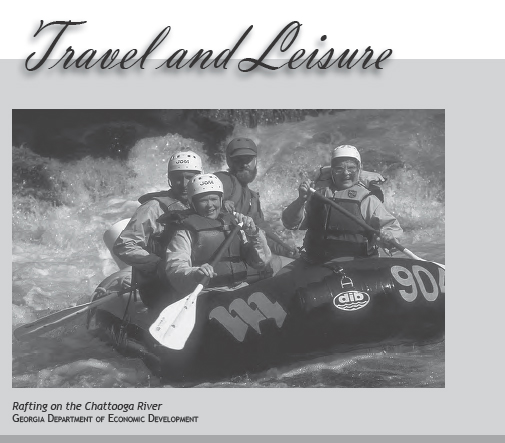
If you’re a newcomer to Georgia, you already may be overwhelmed by how many travel and recreation opportunities the state offers. You’re probably overwhelmed by the traffic in Atlanta, too, but there’s nothing anyone can do about that other than suggesting you take MARTA, the public rail and bus system. What will help is a sampling of places to visit and activities and festivals to attend.
This is by no means a complete guide. The many other books on that subject include the Georgia Travel Guide, the official state publication, available by clicking on the “Travel” section at www.georgia.org. Individual county chambers of commerce offer brochures and information about things to do in their areas.
What follows is a description of some of the state’s most popular attractions, museums, recreational activities, and state parks. Because Georgia has such a diverse geography, it offers something for everyone.
Those who love fishing, boating, or any kind of watersport will find plenty of opportunities to get wet. In North Georgia, canoeists, rafters, and kayakers can test their skills on the wild and scenic Chattooga River or the Coosawattee River. The state has an abundance of lakes, including Carters, Lanier, Oconee, West Point, Sinclair, Seminole, Walter F. George, and Allatoona. Lake Hartwell, Russell Lake, and Clarks Hill Lake—three large reservoirs on the Savannah River—are considered a fisherman’s paradise.
People who would rather have their hair set on fire than spend a night in a tent or cabin in the woods can find more than enough arts and culture in Atlanta, Savannah, Augusta, Macon, Columbus, and other metropolitan areas to fill their social calendars. And folks who prefer the great outdoors to symphony halls and museums have their choice of hiking or camping in the mountains or on an island on the Georgia coast. And if you desire to mingle with alligators and observe bird life, you can visit the Okefenokee Swamp—or the Okefenokee National Wildlife Refuge, as it’s officially called.
Georgia is a place where the Old South and the New South coexist. Fans of Gone With the Wind can go looking for Tara (or plantation houses that inspired Margaret Mitchell). History buffs can explore the archaeological sites of previous civilizations and visit battlefields, forts, and Civil War museums.
Those who couldn’t care less about history can revel in modern cityscapes, cheer on their favorite college or pro sports team, listen to the latest rock, rap, or bluegrass band in concert, or enjoy a dazzling variety of global cuisine, from French and Italian to Thai and Latin. In Georgia, you’re likely to find a sushi bar just down the street from a catfish restaurant, or a Mexican cantina three doors up from a rib shack.
The important thing is to get out of the house or apartment as often as you can to explore this magnificent state. Sadly, some natives and longtime residents have never attended a performance of Swamp Gravy, pigged out at the Big Pig Jig, or nibbled a reptile appetizer at the Whigham Rattlesnake Roundup. Do you really want to die without climbing Stone Mountain or taking a boat tour through the Okefenokee Swamp? Well, maybe so, but everyone should make their own bucket list for Georgia before they, well, kick the bucket.
Not only will you learn about Georgia by traveling from Rabun Gap to Tybee Light and visiting as many of the 159 counties as you can, you also will learn about the people. And as you’ll soon discover, some of the people are far more interesting than anything you’ll find in a museum.
The foothills of the Appalachian Mountains begin about an hour’s drive north of Atlanta. After another 30 or 40 minutes, you’ll find yourself looking up at a range of majestic peaks. Here, you can climb to the top of Brasstown Bald, Georgia’s highest mountain, sit and gaze in wonder at Amicalola Falls, go trout fishing during the season, book a rafting trip on the Chattooga River, or take a 10-mile hike from Unicoi Gap to Tray Mountain. Ambitious hikers can begin the 2,144-mile trek along the Appalachian Trail to Maine.
Gold seekers can try their hand at gem mining in Dahlonega, the site of an early gold rush. If you don’t strike it rich, don’t worry. You’ll find other treasures to savor up here. BlackStock Vineyards, Wolf Mountain Vineyards, Three Sisters Vineyards, Montaluce Winery and Estates, and Frogtown Cellars offer tastings of local wine and bottles of various vintages that you can purchase to take home or carry on a mountain picnic.
One word of caution if you plan to travel to the mountains during leaf season: the roads, especially on weekends, are crowded with thousands of visitors intent on gazing at the fall colors, stocking up on apples and cider from roadside stands, and venturing into Helen, a faux Bavarian village of restaurants, gift shops, and stores selling fudge and funnel cakes. Funnel cakes—fried swirls of dough with powdered sugar—are like beignets, only bigger.
Here are some other places to go and things to see in the northeastern Georgia mountains.
Babyland General Hospital Doll collectors of all ages are drawn to this popular attraction in Cleveland. If you arrive at the right time, you can witness the “birth” of a Cabbage Patch Kid in an old-fashioned medical clinic. Adoptions complete with “authentic” birth certificates can be arranged.

Bratwurst, Beer, and More Helen, the aforementioned Bavarian village, features a variety of things to do besides stuffing your face with fudge, funnel cakes, and sausages. Since the town is located on the Chattahoochee River, tubing and swimming are popular warm-weather events at Cool River Tubing, Helen Tubing, and Waterpark. In the fall, Helen hosts Oktoberfest, a celebration that includes substantial beer consumption. Nora’s Mill Granary, a restored, working mill on the Chattahoochee, is open for demonstrations and the sale of its stone-ground cornmeal and grits. Unicoi Lodge and State Park is only a few miles away. And for an elegant visit, check out Smithgall Woods Conservation Area and Lodge. Catch-and-release trout fishing, hiking, bicycling, and tours are offered by reservation only. Cottages, rooms at the lodge, and meals are available, also by reservation.
While you’re visiting Helen, drive a few miles north on Ga. 255 toward Clarkesville to the Old Sautee Store and Museum. A popular, picturesque tourist spot, the 135-year-old store features nostalgic memorabilia and gifts.
Château Elan Winery and Resort If you look to your left about an hour’s drive north from Atlanta on I-85, you’ll see a view that will make you do a double take. Rising out of what probably was once some farmer’s pasture is a replica of a 16th-century French château. The surrounding fields are now vineyards, and the château itself houses a winery, a gift shop, a restaurant, and an Irish pub. It is situated next to a 275-room inn with more restaurants, a spa, a golf course, tennis courts, and nature trails. Château Elan founder Donald Panoz and his family also offer a racing school and a course for motorcycle races at Road Atlanta in Braselton.
Elvis Yes, every rock-’n’-roll fan knows that Elvis Presley has left the building, but some are determined to keep the King’s legacy alive. On the third floor of the Loudermilk Boarding House Museum in Cornelia, Joni Mabe has assembled the Panoramic Encyclopedia of Everything Elvis. Items include an Elvis Wart (I’m not making this up), the “Maybe Elvis Toenail,” and the official Elvis Prayer Rug, complete with instructions.

Fishing Serious anglers can find plenty of lakes and streams in which to dip their bait and lures, but families with children may want to take the easy way out and let the kids fish at one of the pay-per-pound trout farms. Riverside Trout Farm in Clarkesville charges $4 per pound and furnishes equipment for all ages. Rainbow Ranch Trout Farm in Cumming provides equipment and charges $4.49 per pound. At the Lake Burton Trout Hatchery north of Clarkesville, adults can try to hook a brown or rainbow trout while the kids fish in a stocked catfish pond. Two more pay-for-your-catch lakes are Hickorynut Cove Trout Farm and Upper Hightower Trout Farm in Hiawassee. Andy’s Trout Farm in Dillard rents cane poles and sells bait to any anglers willing to pay $3.60 per pound for every trout caught. You can get your fish cleaned for a fee. The only rule is, you catch ’em, you keep ’em. No throwing back is allowed.
Gainesville This is not the Gainesville where the hated (by UGA fans) University of Florida Gators play. This Gainesville, located near Lake Lanier about an hour north of Atlanta, is the gateway to the North Georgia mountains. Attractions in Gainesville include the Brenau University art collection; the Quinlan Visual Arts Center; the Elachee Nature Science Center and its natural history exhibits, hiking trails, native plants, and live animals; and the Northeast Georgia History Center, which features Chief Whitepath’s 1870s cabin.
South of Gainesville, Lake Lanier Islands Resort offers two golf courses, a water park, a hotel, a beach, and boat rentals.
Hot Wheels, Hopping Marsupials, and More Dawsonville has the distinctions of being the home of NASCAR legend Bill Elliott and the location of the largest kangaroo collection outside Australia. You can learn more about “Awesome Bill from Dawsonville” at Georgia’s Racing Hall of Fame, located east of town. As for the kangaroos, you can see them and other exotic animals at the Kangaroo Conservation Center, located at 222 Bailey-Waters Road.
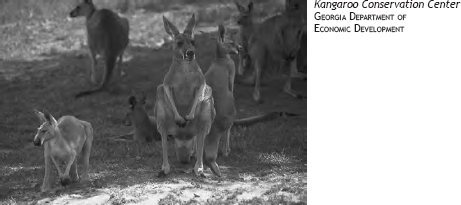
If kangaroos are not exotic enough for you, venture over to Hiawassee to the Crystal River Ranch for a visit with some llamas. Agricultural demonstrations and treks with the llamas are offered. And if you decide a llama would make a wonderful addition to your farm or suburban backyard, you can buy one starting at $500 (for males).
In Royston, Fancy Feather Farms lets visitors get up close and personal with ostriches, emus, and miniature goats. Tours are by appointment. Royston, by the way, was home to baseball legend Ty Cobb. Some of Cobb’s memorabilia and photographs are exhibited at the Ty Cobb Museum.
Jefferson Two attractions are worth your while in this town, known as “the birthplace of anesthesia.” The Crawford W. Long Museum offers exhibits about the life and career of Dr. Crawford W. Long, who first used ether to perform “painless” surgery on March 30, 1842, in Jefferson. You can continue your educational tour with a visit to Shields-Etheridge Heritage Farm, an outdoor agricultural museum with a gristmill, a restored schoolhouse from the early 1900s, a cotton gin, and a blacksmith shop.
Pottery and Crafts You can find handcrafted pottery at most galleries in North Georgia. In addition, you can see the artists’ works in their studios during the Mountain Heritage Arts Tour, held the last weekend in June. The tour includes the picturesque Mark of the Potter on the Soque River, Hickory Flat Pottery and the Burton Gallery in Clarkesville, and the Folk Pottery Museum in Sautee. The Sautee museum features the work of some of the region’s outstanding potters, including Lanier Meaders. More clay products can be seen and purchased at Turpin Pottery in Homer and Crocker Pottery–Georgia Folk Pottery Center in Lula.
Other arts and crafts are on display at the Georgia Heritage Center for the Arts in Tallulah Falls and Clarkesville, Blue Bell Gallery and Bendzunas Glass Studio and Gallery in Comer, and the Funky Chicken Art Project in Dahlonega. And gourds galore are available at The Gourd Place in Sautee. The museum and shop showcase more than 200 gourds from all over the world.
History buffs and lovers of the outdoors have plenty to see and enjoy in this part of the state. Visitors to Civil War battlefields in Lookout Mountain, Chickamauga, Pickett’s Mill, and Allatoona Pass can walk some of the same roads used by Union and Confederate soldiers and view the old trenches and earthworks.
Those interested in earlier periods of history can tour the Etowah Indian Mounds Historic Site and learn about some of the first inhabitants on the continent. The story of the Cherokees and the Trail of Tears is told in exhibits at the Chieftains Museum in Rome. New Echota, the former capital of the Cherokee Nation, is located in Calhoun. Visitors can learn about another interesting chapter in Cherokee history at the Chief Vann House and Museum in Chatsworth. The brick mansion was built in 1804 for James Vann, a controversial half-Scottish, half-Cherokee chief considered one of the richest men in America. He also made a lot of enemies and was murdered by an unknown assailant.
Thanks to Lake Allatoona, Carters Lake, and Lake Blue Ridge, this area has no shortage of fishing and boating opportunities. Hikers and backpackers can challenge themselves on the rugged Cumberland Plateau, where Tennessee, Alabama, and Georgia meet. And the area’s deep canyons and limestone caves make it an attractive destination for hang gliders and spelunkers.
More hiking trails are located in the Cloudland Canyon, Red Top Mountain, and Lookout Mountain areas. The Silver Comet Trail, a 37-mile handicapped-accessible paved track between Smyrna and Rockmart, is well used by hikers, roller-bladers, and cyclists (only nonmotorized bikes are allowed).
Northwestern Georgia is one of the most scenic regions in the state, especially along the Lookout Mountain Parkway and the Ridge and Valley Scenic Byway. If you go eastward to Blue Ridge, be sure to take a ride on the Blue Ridge Scenic Railway and treat the family to a movie at the nostalgic 1950s Swan Drive-In Theatre.
Here are a few more highlights.
Apples Galore You’ll find enough apples in Gilmer County to keep doctors away for months. The state’s apple capital has 11 orchards along Ga. 52. The town of Ellijay hosts the Apple Festival every fall. Panorama Orchards offers seasonal pick-your-own apples and apple products all year long. Hillcrest Orchards sells sorghum syrup and other farm products, as well as apples. Activities in the fall include wagon rides and a petting zoo.
Barnsley Gardens Resort in Adairsville The Italianate villa and the surrounding gardens were built by Godfrey Barnsley for his wife, Julia, in the 1840s. A series of tragedies—including Julia’s death, damage during the Civil War, and a 1906 tornado—left the once-beautiful estate in ruins. Prince Hubertus Fugger bought the property in 1988 and restored the gardens and the manor house as a resort destination with luxurious cottages.
Cartersville One must-see attraction is the Booth Western Art Museum, which features an impressive collection of Western and Civil War art. More than 200 paintings and sculptures depict the history and legends of the Old West. One section includes Western movie posters. While you’re in Cartersville, stop by the Allatoona Pass Battlefield to see the earthen forts and the miles of trench works where Union and Confederate forces clashed on October 5, 1864. And don’t forget the Etowah Indian Mounds Historic Site, where Native Americans lived before 1550 A.D., and Tellus, the Northwest Georgia Science Museum, which offers mineral and fossil exhibits and science experiments.
Flicks under the Stars If you remember Elvis, you’ve probably gone to at least one drive-in theater. But you probably haven’t seen one like Trenton’s Wilderness Outdoor Movie Theater, billed as the world’s largest single-screen outdoor movie theater and drive-in. You can watch the film from your car or sit outside on a hillside.
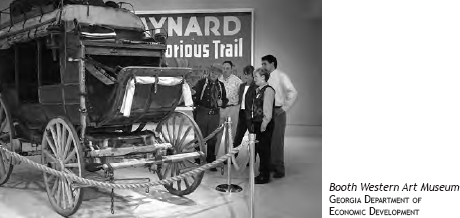
Howard Finster’s Vision House The house in Summerville where folk artist Howard Finster said he received a vision from God to paint sacred art is now a museum and gallery showcasing the late artist’s work.
Life on the Farm You can show the kids where milk comes from and try to find your way through the corn maze at Cagle’s Dairy Farm in Canton. Tours of the farm and gardens are available. Nearby Tanglewood Farm Miniatures features more than 100 really small animals, including dwarf bunnies and potbelly pigs. Petting is encouraged.
Peaks and Valleys Visitors who are not afraid of heights can learn to hang glide at Lookout Mountain Flight Park and Training Center in Rising Fawn. Those who like to keep their feet on the ground can explore along the ridge at Cloudland Canyon State Park or descend to the bottom and look up at the waterfalls.
Pieces of History In Chickamauga, plan on touring the Gordon-Lee Mansion, an antebellum house used during the Battle of Chickamauga, and the Lee and Gordon Mills, one of the oldest operating mills in the state with one of the oldest general stores. In Dalton, stop and see Prater’s Mill, a gristmill built in 1855. A country fair is held here in October. For additional glimpses into the past, visit the Funk Heritage Center and Appalachian Settlement, Georgia’s official Frontier and Southeastern Indian Interpretive Center, located in Waleska.
Rock City Folks who grew up in the South remember seeing red barns with their roofs painted in bold white letters urging travelers to “SEE ROCK CITY.” Today, only a few of those barns are left, and replicas are sold as birdhouses. Well, in Lookout Mountain, you can finally inspect the Rock City Gardens up close. More than 400 species of native plants grow along a path that leads through gardens and rock formations.
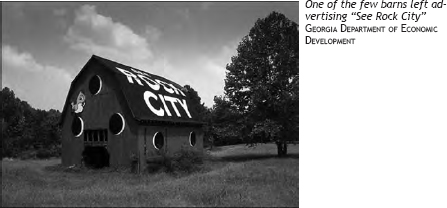
Stuffed and Mounted You can see a large collection of taxidermy at Bud Jones Taxidermy Museum in Tallapoosa. In addition to displays of preserved exotic animals, Jones has an impressive collection of fossils.
Atlanta is a booming city that is the corporate headquarters of Delta Air Lines, UPS, Coca-Cola, CNN, and other companies. It is the home of the Atlanta Braves, the Atlanta Hawks, the Atlanta Falcons, the Atlanta Thrashers, and the Atlanta Dream, a women’s professional basketball team.
The city and the surrounding metro area offer all the entertainment you would expect in a large urban center: live theater; art museums; ballet; a symphony orchestra; blues, bluegrass, rap, and rock concerts; and more. You can see pandas at Zoo Atlanta, whale sharks and other denizens of the deep at the Georgia Aquarium, and more than 100 years of Coke memorabilia at the New World of Coca-Cola. Tours are available of CNN’s news operation just across from Centennial Olympic Park, a 21-acre green space that features the Olympic Ring Fountain and playgrounds.
History buffs can tour Civil War sites; experience the sights and sounds of the Battle of Atlanta at the Cyclorama; visit Martin Luther King, Jr.’s, birth home and historic Ebenezer Baptist Church, where he first preached; learn more about the historical events in the city’s past at the Atlanta History Center; and walk through “The Dump,” the house where Margaret Mitchell wrote Gone With the Wind.
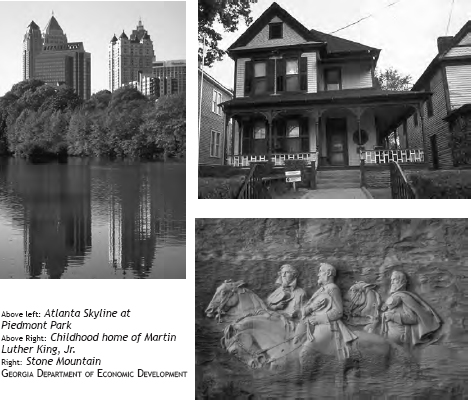
For family fun, Six Flags Over Georgia offers rides for kids and grownups, including some of the most scream-inducing roller coasters you’ll ever climb aboard. East of Atlanta, Stone Mountain Park features scenic train rides, a paddlewheel boat tour, a sky ride to the top of the mountain, campgrounds, and a nightly fireworks and laser light show in front of the giant carvings of Stonewall Jackson, Robert E. Lee, and Jefferson Davis.
And of course, there’s shopping. Atlanta is surrounded by malls, but Lenox Square and Phipps Plaza are the most accessible for shoppers staying in the downtown area. If you don’t mind driving an hour, you can visit Gwinnett Place Mall, Discover Mills, and the Mall of Georgia, located along I-85 North. Back downtown, souvenir seekers can venture below the city streets to Underground Atlanta for shops, entertainment, dining, and a glimpse of what Atlanta looked like decades ago.
Entire books have been written on the things to do and places to go in Metro Atlanta. The following are a few other highlights.
Atlanta Botanical Garden Visitors can stop and smell the flowers—and other plants—in this 30-acre garden in midtown Atlanta.
Atlanta History Center This center features exhibits tracing the city’s growth from a small railroad town to a sprawling metropolis. Located on the center’s 32 acres of woods and gardens are the Tullie Smith House, an 1840s plantation house typical of upcountry Georgia, and the Swan House, a 1924 mansion built by Atlanta banker Edward Inman. The house is decorated with swans in the woodwork and wallpaper.
Auburn Avenue Historic District Locally known as “Sweet Auburn,” this part of Atlanta was a thriving black entertainment and business district from 1890 until the 1930s. After a period of decline, it has undergone a renewal. Along Auburn Avenue, you’ll find Ebenezer Baptist Church, the Martin Luther King Jr. Center for Nonviolent Social Change, and the birthplace of Martin Luther King, Jr.
Chattahoochee River National Recreation Area Visitors can hike and picnic along the scenic banks of the Chattahoochee.
DeKalb Farmers Market If you’re not hungry when you arrive at this gigantic international market in Decatur, you will be before you leave. Fruits, vegetables, fish, and meat from around the world are sold here. You’ll hear conversations in more languages than you can identify. A restaurant and bakery are conveniently located in the market.
Fernbank Museum of Natural History Here, you can feast your eyes on replicas of the giant dinosaurs that once feasted on anything they could catch. Exhibits explain the earth’s history. The IMAX theater features breathtaking documentaries on the natural world.
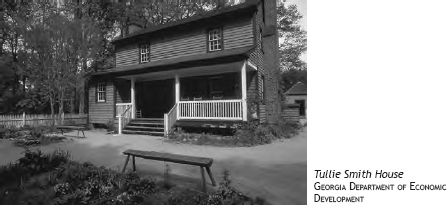
Fernbank Science Center Not to be confused with the Fernbank Museum, this learning center surrounded by 65 acres of forest features a NASA education lab and a 500-seat planetarium.
Final Resting Places If you’re one of those people who like to tour old cemeteries, you’ll find unique gravestones at Atlanta’s Historic Oakland Cemetery marking the remains of Confederate soldiers, Margaret Mitchell, Bobby Jones, and other notable Atlantans. North of Atlanta, more than 10,000 Civil War soldiers are buried in Marietta National Cemetery. The Marietta Confederate Cemetery/Marietta City Cemetery has graves dating back to the 1830s.
Fox Theatre This 1929 Moorish-Egyptian-style structure, built for the Shriners Club, was turned into a movie theater by film mogul William Fox. Even if you don’t go here for one of the summer movies or touring Broadway shows, take a tour just to see the architectural details, including the ceiling with special effects that change the sky from a light blue with clouds to a night scene with stars.
Georgia Aquarium Billed as “the world’s largest aquarium,” this 8-million-gallon Atlanta fishtank showcases more than 120,000 fish and animals, including whale sharks and penguins.
Georgia State Capitol and Museum Visitors learn about the state’s political history from a collection of artifacts and artwork beneath the gold dome.
Gone With the Wind Fans of the book and movie can learn about the author at the Margaret Mitchell House & Museum in Atlanta. Early photographs and writings are on display, and the restored apartment where she wrote the famous novel is available for tours. You can find more GWTW memorabilia at the Road to Tara Museum in Jonesboro and Scarlett on the Square, the Marietta Gone With the Wind museum. The Marietta museum has a section devoted to African-American cast members from the film.
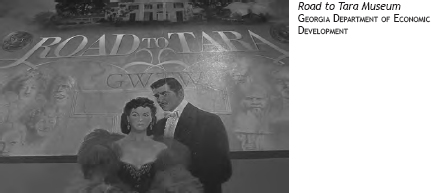
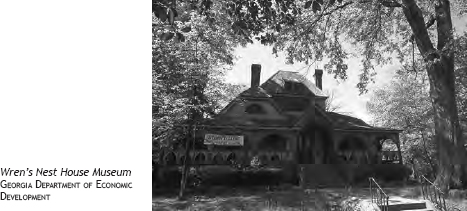
High Museum of Art Here, you can view masterpieces by American and European artists, the impressionists, and folk artists, as well as traveling exhibitions from the Louvre.
Jimmy Carter Library and Museum The story of the former president’s early life and White House years unfolds in a number of exhibits.
New World of Coca-Cola The history of the world’s most famous drink is told in exhibits, films, and a pop culture gallery. The tasting room features 70 different beverages from around the world.
White Water and American Adventures You can get all wet at this theme park in Marietta featuring water slides, a wave pool, and the Cliffhanger, one of the world’s highest free falls.
Wren’s Nest House Museum The home of Joel Chandler Harris, creator of the Uncle Remus tales, is now a museum that offers tours and storytelling.
Zoo Atlanta Of course, you’ll find lions and tigers and bears here, but the pandas from China are the stars of the show.
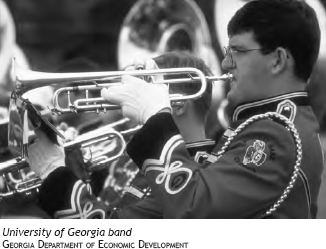
The “Classic City” is famous as the home of the University of Georgia, R.E.M., and the B-52s. It also is a picturesque city with many antebellum homes. Fortunately for the owners of these mansions, Union general William T. Sherman was too busy burning Atlanta to divert his March to the Sea 65 miles eastward to Athens. One of these grand dwellings is the Taylor-Grady House, the 1844 Greek Revival mansion where Atlanta Constitution editor Henry Grady lived while attending college. Tours are available for this as well as the T. R. R. Cobb House, home of the author of the Confederate Constitution, and the 1825 Wray-Nicholson House, which is now the headquarters of the UGA Alumni Association.
Athens has a number of interesting clubs, restaurants, and attractions, but you don’t want to visit them on a football weekend—unless you have tickets to the game. No matter who the Bulldogs are playing, more than 92,000 screaming fans pack Sanford Stadium. Those who don’t climb into their cars to navigate the traffic jam hang around to patronize the clubs and restaurants downtown.
Besides being a center of sports and music, Athens has become something of a literary town, thanks to the several authors who live in the vicinity and the national reputations of the University of Georgia Press and the Georgia Review.
Watkinsville, located eight miles south of Athens on Ga. 441, is a revitalized small town that has become an arts-and-crafts center noted for its antique shops and galleries. The Eagle Tavern, which served as a stagecoach stop in the 19th century, is now a crafts shop and welcome center.
Located 40 miles east of Athens, Washington is a town of about 5,000 that was named for our first president. It features annual tours of antebellum homes, including the white-columned Robert Toombs House. Toombs was the Confederacy’s secretary of state for five months. He resigned to serve as a brigadier general in the Army of Northern Virginia.
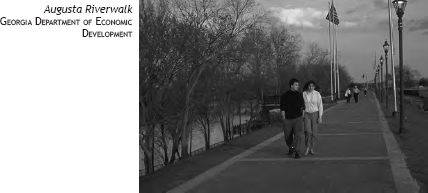
Founded as a trading post in 1735 by General James Oglethorpe, this city on the Savannah River is best known as the site of the Masters Tournament at Augusta National Golf Club every April.
The oldest and largest city in this part of the state, Augusta is a place where the Old South meets the New South. Like Athens, Augusta survived the Civil War with most of its historic buildings undamaged. That’s the Old South. Part of the city’s New South image is represented by Riverwalk, a redeveloped section of antique shops, art galleries, and restaurants along a levee on the Savannah River. The 1886 Cotton Exchange in Riverwalk is a visitor center and museum offering exhibits about the history of the cotton trade in Augusta. Riverwalk is the location of several festivals during the year, including Oktoberfest and the Junior League’s Festival of Trees.
Augusta is also the home of the Morris Museum of Art, a facility specializing in Southern art. Its paintings include Southern landscapes, Civil War art, and folk art.
Other points of interest include Artists’ Row, a series of shops and studios on Broad Street; the Lucy Craft Laney Museum of Black History; the Laney-Walker Historic District; the Sacred Heart Cultural Center, where two of the three Georgia signers of the Declaration of Independence are buried; and Phinizy Swamp Nature Park, which offers trails and observation decks where visitors can watch alligators, hawks, and other wildlife.

Augusta also can claim a connection to two famous individuals in widely different fields. President Woodrow Wilson spent his childhood at a house on Seventh Street, and James Brown, “the Godfather of Soul,” learned his music and his moves in Augusta. Check with the Augusta Convention and Visitors Bureau for information about a James Brown tour of 13 special sites.
Savannah is the oldest city in Georgia—and also arguably the most Irish. On St. Patrick’s Day, anyone with the most tenuous connection to Ireland shows up to watch the parade, enjoy the music, and drink green beer. Stay away if you are uncomfortable in crowds. Otherwise, put on your green and join the festivities.
Savannah is both a charmed and a charming city. General Sherman reportedly was so taken by its beauty that he refused to burn the elegant homes. Instead, he presented Savannah to President Abraham Lincoln as a Christmas present.
The city has survived devastating hurricanes, fires, and unbridled growth. While industries and shopping malls have sprung up around Savannah, the downtown, with its moss-draped oaks and shaded streets, has retained the charm of a colonial village.
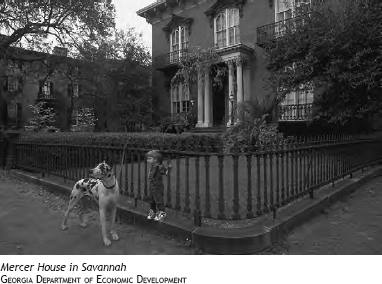
The one thing Savannah almost didn’t survive was the attention it got when a New Yorker named John Berendt decided to write about a scandalous murder trial involving well-known antique dealer Jim Williams. Covering the trial would have been scandalous enough, but Berendt also included detailed portraits of some of Savannah’s more, shall we say, “eccentric” characters in Midnight in the Garden of Good and Evil.
Other people would have been embarrassed, but the citizens of Savannah opened their arms and their businesses to the flood of tourists that arrived as a result of the best-selling book. Then came the movie, directed by Clint Eastwood. Tourism figures hit the roof.
Now, Midnight in the Garden of Good and Evil tours add to an already full slate of things to see and do in Savannah. Among the stops on the Midnight tour are the Mercer House on Bull Street, the Italianate mansion where the murder took place; the Hamilton-Turner House on Abercorn Street, the home of Joe Odom, the charming con man in the book; and Bonaventure Cemetery, where the “bird girl” pictured on the cover of Midnight resided.
If you drive south from Atlanta along the coast, you eventually will reach St. Simons Island and the Golden Isles. This sparkling necklace of islands has been fought over by Creek and Guale Indians, the Spanish, and the British. Britain finally triumphed in 1742 at the Battle of Bloody Marsh on St. Simons Island.
Cotton and rice planters cultivated the fertile soil of the islands and built great plantation houses during the 18th and 19th centuries. Then, in the late 1800s, Henry Ford and other millionaires bought Jekyll Island and formed the Jekyll Island Club as an exclusive winter resort. The state bought Jekyll in 1947 and opened it to anyone who wanted to play golf or tennis, go biking or hiking along the moss-draped trails, or sunbathe on the white beaches.
Nearby St. Simons Island also offers golf and resort living. Cumberland Island, the southernmost in the chain, is a protected wilderness noted for its wild horses, birds, and other wildlife. Once owned by Thomas Carnegie, brother of Andrew Carnegie, Cumberland is now administered by the National Park Service. It is accessible only by ferry.
Here are some other coastal attractions.
Blackbeard Island Named for famous pirate Edward Teach, this island is now a wildlife refuge offering hiking trails and places for bird watching. It is accessible by a short boat or canoe ride from Sapelo Island.
Butler’s Island In 1788, Major Pierce Butler established one of the world’s largest rice plantations on this site near Darien. His wife, British actress Fanny Kemble, recorded her critical views of slavery and colonial life in Journal of a Residence on a Georgian Plantation.
Hofwyl-Broadfield Plantation Located 78 miles south of Savannah in Brunswick, this rice plantation features educational exhibits, a slide show, and a scenic trail among the rice levees.
Jekyll Island The Georgia Sea Turtle Center has interactive exhibits and demonstrations about turtles. The Jekyll Island Museum and the Jekyll Island Club National Historic Landmark District feature exhibits about the island’s history.
Ossabaw Island Georgia’s third-largest barrier island offers hiking, camping, and guided tours.
Sapelo Island Visitors can explore Hog Hammock, an African-American Geechee community whose residents are descended from slaves, on this beautiful, unspoiled island. A ferry ride is required to reach Sapelo. Guided tours can be booked through the Sapelo Island Natural Estuarine Research Reserve.
Savannah The best way to see Savannah for the first time is to book one of the many tours. Contact the Savannah Visitors and Convention Bureau (www.savcb.com) for tours and information. If you decide to explore Savannah on your own, your first stop should be River Street, the nine-block stretch along the river with old cotton warehouses that have been converted into shops, pubs, art galleries, hotels, and restaurants. While you’re on River Street, stop at the Ships of the Sea Maritime Museum, housed in the 1819 Scarbrough House. William Scarbrough was one of the financial backers of the Savannah, the first steamship to cross the Atlantic. Models of the Savannah and other ships, maritime antiques, and memorabilia are exhibited here. And don’t miss the Waving Girl statue of Florence Martus in Riverfront Plaza. Martus greeted passing ships every day for 50 years. Some say she was awaiting the return of the sailor she loved. Others suggest she did it out of boredom. Savannah offers many excellent dining experiences, including TV chef Paula Deen’s Lady & Sons restaurant, at 102 West Congress Street.
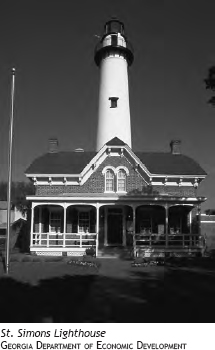
St. Simons Island The most prominent landmark on the island is the St. Simons Lighthouse. Visitors can climb to the top for a view of the ocean and the fishing pier at Neptune Park. Tours of the Museum of Coastal History and the Coastal Encounters Nature Center are available.
Tybee Island Georgia’s oldest and tallest active lighthouse houses a museum with exhibits about the island’s history. Visitors can learn about Georgia’s fish and wildlife at the Tybee Island Marine Science Center, which offers aquariums and a touch tank.
Waycross: Obediah’s Okefenok, home of “King of the Okefenokee” Obediah Barber, features a variety of native and exotic animals. The Okefenokee Heritage Center offers exhibits on South Georgia history.
This region south of Atlanta is dotted with picturesque little towns and some of Georgia’s most beautiful homes. If you’re looking for houses that resemble Tara or Twelve Oaks, you’ll find them in the historic town of Madison. Examples include Heritage Hall, a restored 1833 mansion, and the Rogers House, an 1804 Piedmont Plain–style townhouse.
The 1996 Olympic Games were held mainly in Atlanta, but the Georgia International Horse Park in Conyers was the site of the equestrian and mountain-biking events. Visitors today can use the horse and biking trails and attend special events. Conyers also is the home of the Monastery of the Holy Spirit, which includes the Abbey Church, a gift shop, and a bonsai garden. Tours and religious retreats are available.
Eatonton is famous for two authors: Alice Walker and Joel Chandler Harris. Walker, author of The Color Purple, grew up here. Harris, who created the Uncle Remus tales about Br’er Rabbit and Br’er Fox, is commemorated in the Uncle Remus Museum. A statue of Br’er Rabbit stands on the courthouse square. Eatonton also is known for the Rock Eagle Effigy, a prehistoric rock effigy of a giant eagle believed to have been created by the Creek Indians about 5,000 years ago.
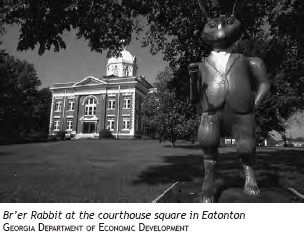
Another famous writer—one of the most famous in America—lived and worked in nearby Milledgeville. Flannery O’Connor’s home at Andalusia Farm is open for tours. A collection of memorabilia is displayed at the Flannery O’Connor Memorial in the Ina D. Russell Library on the campus of Georgia College and State University. One of the early capitals of Georgia, Milledgeville is the site of the Old Governor’s Mansion, a restored 1850s building, and the Old State Capitol Building, which houses exhibits on local history.
The small community of Juliette, located a few miles off I-75, is well worth a detour if you are a fan of the movie Fried Green Tomatoes. You can sample the fried delicacy at the Whistle Stop Café, tour the town, and visit the Old Mill Motorcycle Museum to see displays of vintage cycles. You can also tour the museum, farmhouse, gristmill, and cotton gin at the Jarrell Plantation Historic Site.
Macon, located an hour-and-a-half drive from Atlanta on I-75, is the music capital of the state. This is the city that produced Little Richard, Otis Redding, Capricorn Records, and the Allman Brothers Band, among others. The Georgia Music Hall of Fame celebrates all of Georgia’s musical talent, including Ray Charles, Brenda Lee, R.E.M., Bill Anderson, and Ronnie Milsap. Macon is more than just music. Two highlights of the year are the Cherry Blossom Festival, when 270,000 cherry trees burst into bloom, and the nightly Lights on Macon tour, when thousands of lights illuminate some of the city’s historic landmarks.
Here are some other places of interest in the heartland.
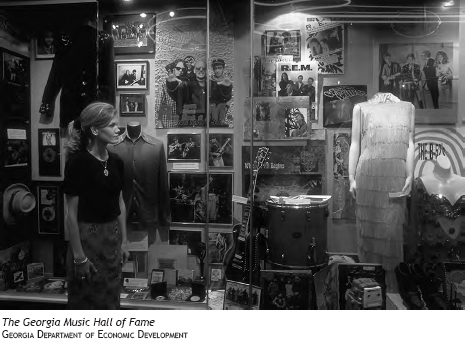
Blue Willow Inn and Village Located in Social Circle, this restaurant in a 1907 Greek Revival mansion specializes in Southern food. A gift shop adjoining the restaurant sells Blue Willow china, among other things. The house was built by John Upshaw, uncle of Margaret Mitchell’s first husband, Red Upshaw. Some GWTW fans surmised that Red Upshaw was the model for Rhett Butler, but Mitchell remained mum on the subject.
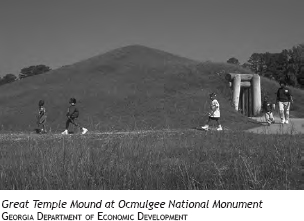
Cannonball House and Civil War Museum Although Macon suffered little damage during the Civil War, local history buffs are particularly proud of the Cannonball House. Union troops apparently were aiming for the Hay House, an elegant Renaissance Revival mansion built in the 1850s, and hit the house two doors down by mistake. The cannonball itself is still on display.
Charlie Elliott Wildlife Center This 6,400-acre preserve in Mansfield offers hiking, birding, hunting, and camping. Anglers can try their luck in one of the 29 ponds.
Georgia Sports Hall of Fame Opened in 1999 in Macon, this building was designed to resemble a turn-of-the-20th-century ballpark with a green roof and a red-brick exterior. Inside are exhibits honoring more than 300 members, including Hank Aaron, Bobby Jones, and Ty Cobb.
Ocmulgee National Monument This is where a civilization of Native Americans known as the Mississippians lived and died from 900 A.D. to 1100 A.D. The site on the Emery Highway near Macon includes the 45-foot Great Temple Mound, walking trails, and an archaeological museum.
Rose Hill Cemetery This resting place of more than 600 Civil War soldiers is also where Duane Allman and Berry Oakley of the Allman Brothers Band are buried side by side in graves outlined in the shape of electric guitars.
Sidney Lanier Cottage This is the birthplace of Georgia’s most famous poet, Sidney Clopton Lanier. Lanier’s best-known poems are “The Marshes of Glynn” and “Song of the Chattahoochee.”
This south-central region of Georgia does indeed have an abundance of magnolias, but it also boasts four state parks, 20 public golf courses, lakes, rivers, lush farmland, and enough intriguing backroads to satisfy the most adventurous travelers. And don’t forget all the farm produce and Vidalia onions. Even if you don’t like onions—and a few odd people don’t—you’ll probably change your mind after tasting this sweet vegetable grown only in this part of the state. To learn more about these onions, or to sample onion products, take a tour of the UGA Vidalia Onion and Vegetable Research Center or Vidalia Onion Factory and Gifts. Both are in Vidalia, of course.
The midlands are a haven for fishermen, kayakers, and nature lovers. The Altamaha River, which ends on the coast, is formed where the Oconee, Ohoopee, and Ocmulgee rivers converge. The Nature Conservancy has listed the Altamaha as one of the “75 Last Great Places” because of the diversity of wildlife and native plants on its banks. And visitors to Moody Forest Natural Area in Baxley, with its forests of 300-year-old longleaf pines and 600-year-old tupelo cypress trees, can see what this part of Georgia looked like when the first settlers arrived.
Like the rest of the state, this region is steeped in history. Irwinville, home of Jefferson Davis Memorial State Historic Site, is famous as the location where the president of the Confederacy was captured in 1865.
Here are a few other places and attractions to consider.
Dublin This picturesque town about 45 miles south of Macon off I-16 was founded by Irish settlers in 1812. That’s why it goes all out for St. Patrick’s Day every year. Dublin is also the home of another celebration that may or may not be something that makes citizens proud. Every summer, East Dublin is the site of the Redneck Games, a tongue-in-cheek festival featuring seed spitting, big-hair contests, cigarette flipping, hubcap hurling, and mud-pit belly flops.
Fruits and Nuts You can get your Christmas dessert any time of the year in Claxton, “the Fruitcake Capital of the World.” Tours (and samples) are available at the Claxton Bakery and the Georgia Fruit Cake Company. Visit the Pecan Orchard Plantation in Mount Vernon for pecans, a petting zoo, and an up-close look at a working farm. Strawberries, blackberries, peaches, and other pick-your-own fruits are available seasonally at Tom Sawyer Farms in Roddy. Clark Farm and Produce sells strawberries and pumpkins in season, along with homemade ice cream. In Reidsville, check with Farm Fresh Tattnall on South Main Street for directions to pick-your-own farms in the county. And in Dublin, be sure to visit the Market on Madison, where local farmers bring their produce to sell.
Guido Gardens If you’re looking for a quiet place to meditate, stop at these gardens in Metter. Named for syndicated radio evangelist Michael Guido, the gardens feature a prayer chapel, fountains, waterfalls, and inspirational music.
Statesboro The home of Georgia Southern University offers several fascinating attractions. The Center of Wildlife Education and the Lamar Q. Ball Jr. Raptor Center present demonstrations featuring birds of prey and programs about reptiles. At the Georgia Southern University Museum, you can view prehistoric remains, including a 26-foot fossil of a mosasaur.
This southwestern part of the state is a prime peanut-farming area. It’s also home to the world’s most famous peanut farmer, former president Jimmy Carter. Carter’s hometown of Plains is still a favorite stop for tourists, as is the Little White House in Warm Springs, where President Franklin D. Roosevelt stayed on trips to treat his legs in the warm mineral springs.
Nearby Americus is the birthplace and headquarters of Habitat for Humanity. The idea for the volunteer organization began at Koinonia Farms, a utopian community that also started the Prison and Jail Project. Founded in 1942, Koinonia Farms still grows pecans, peanuts, and blueberries.
Columbus is the largest city in the area and the third-largest in the state. Founded as a frontier town on the Alabama border in 1827, Columbus supplied cannons and ironclad ships for the Confederacy. The city still retains much of its Old South charm while building for the future. A good example is the South Commons. Formerly a city dump and hospital for highly contagious patients, it is now a public green space and the site of the restored Memorial Stadium, the Columbus Civic Center, and Golden Park, where minor league baseball games are played.
Columbus is the home of Fort Benning, the largest infantry training facility in the world, and the birthplace of Carson McCullers, author of The Heart Is a Lonely Hunter. The city has a vibrant arts scene that includes museums, galleries, the Columbus Symphony Orchestra, and the historic Springer Opera House.
Here are some other places to visit in the area.
Andersonville National Historic Site A national cemetery, the National Prisoner of War Museum, and the remains of a stockade from a Civil War prison camp are stark reminders of the horrors of war. Nearly 13,000 Union prisoners held in Andersonville died from disease or starvation.
Callaway Gardens Located in Pine Mountain, this private resort is set amid 2,500 acres of forests and flower gardens with hiking and biking trails, a 65-acre lake, golf courses, the Cecil B. Day Butterfly Center, and the John A. Sibley Horticultural Center. During summer, acrobats from the Florida State University circus perform regularly.
Fort Benning The list of army legends who have served at the Infantry School of Arms here includes Generals George Patton and Dwight Eisenhower. The National Infantry Museum, located on the base, offers a collection of historic weapons and a re-created World War I barracks.
Ma Rainey House This house at 805 Fifth Avenue in Columbus was the last home of Gertrude Pridgett “Ma” Rainey, a famous gospel and blues singer in the 1920s.
Pasaquan This unusual art site in Buena Vista was created by Eddie Owens Martin, a sharecropper’s son who changed his name to St. EOM when he became a folk artist. The exhibits include sculptures, colorful paintings, and totems from other cultures.
Springer Opera House Located in Columbus, this was considered one of the finest entertainment venues in the Southeast in the days when performers such as Will Rogers entertained packed houses. After a period of deterioration, the theater was saved from demolition and restored to its former glory by a group of concerned citizens in the 1960s. The Springer is now the official State Theater of Georgia.
Westville Located just outside Lumpkin, Westville is a re-creation of an 1850s town. The first house from that period was moved here in the late 1960s. Now, the town has 33 buildings, including a courthouse and a shoemaker’s shop. Craftspeople perform their tasks dressed in authentic costumes.
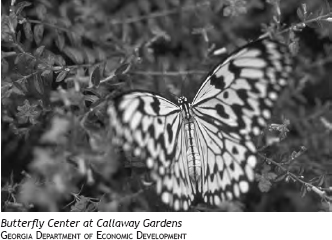
Habitat for Humanity International
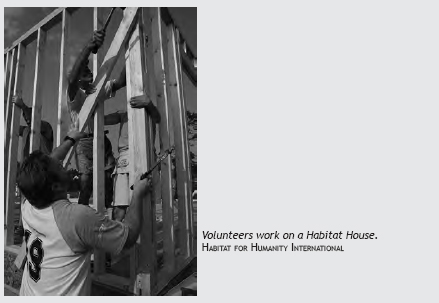
Most Americans are familiar with Habitat for Humanity and its mission of building homes for people who could not otherwise afford them. Through volunteer labor and donations of money and materials, Habitat builds and rehabilitates simple, decent houses with the help of the homeowner (partner) families. Habitat houses are financed with affordable loans and sold to partner families at no profit. The homeowners’ monthly mortgage payments are used to build still more Habitat houses. To date, Habitat volunteers have built or rehabilitated nearly 300,000 houses worldwide.
Habitat has dual headquarters in Americus and Atlanta. The organization was founded by Millard and Linda Fuller after the couple had become part of Koinonia, an interracial Christian community. The Fullers and Koinonia’s founder, Clarence Jordan, developed a plan according to which volunteers would work with those in need to build affordable housing.
After building houses for thousands of Americans, Habitat expanded to other countries in 1973. The hands-on involvement of former president Jimmy Carter and his wife, Rosalynn, increased the visibility of Habitat for Humanity and sparked an increase in aliates.
But reading about the success of Habitat for Humanity is not nearly as inspiring as seeing the results. At the Global Village and Discovery Center in Americus, visitors can tour a village of poverty housing and compare it with full-sized models of the types of houses Habitat has built in more than 15 countries, including Guatemala, Ghana, and Papua New Guinea.
Located at 721 West Church Street in Americus, the Global Village and Discovery Center is open Monday through Friday from 9 A.M. to 5 P.M. and Saturday from 10 A.M. to 2 P.M. from March through November. For information on the center, call 800-HABITAT, extension 7937, or visit www.habitat.org/gvdc. For information about Habitat for Humanity, visit www.habitat.org.
This region is a land of pecan orchards, cotton fields, and pine forests. Once the home of ancient tribes of Native Americans, the land eventually was taken over by white settlers who came to carve out small farms. They were followed by timber barons and plantation owners who built elegant white-columned mansions.
The area was invaded again in the late 19th century when wealthy Northerners fled the bitter winters above the Mason-Dixon line. Resort hotels opened, and thousands of acres were transformed into quail- and fox-hunting retreats for the elite.
Here are the region’s sightseeing highlights.
Albany You’ll give native Georgians a sure sign that you’re not from around here if you mispronounce the name of this city about 190 miles south of Atlanta. It’s al-BENNY, not ALL-bany. Located on the Flint River, Albany is “the Quail Capital of the World.” More than 40 former cotton plantations have been converted to hunting preserves. Points of interest in Albany include the Albany Civil Rights Institute; the FlintRiverQuarium, a freshwater aquarium; and the Parks at Chehaw, where you’ll find a wild animal park and a hiking trail.
Georgia Agrirama Visitors can see what life was like on a working farm in the 1800s. Costumed guides conduct tours of two farmsteads and other exhibits at this living-history museum in Tifton.
Thomasville Home of author Bailey White, this picturesque town attracted droves of Northern millionaires in the late 1800s after a medical article touted the health benefits of the pine-scented air. Many of the hunting plantations established then are still in business. Plantation houses open for tours include Pebble Hill Plantation, an 1820s Greek Revival mansion furnished with antiques and 33 original Audubon prints, and the Lapham-Patterson House, an 1884 Victorian mansion. Thomasville also is a city of roses. The Rose Test Gardens on U.S. 84 showcase 500 varieties of roses around a gazebo. Visitors can learn about local history at the Thomas County Historical Museum, which features vintage cars and a Victorian bowling alley.
Valdosta Located 230 miles south of Atlanta, Valdosta is the home of Valdosta State University. It’s also known as “the Azalea City” because of its many flowering gardens. Three National Register Historic Districts are located in town—the downtown, Patterson Street, and Victorian Fairview. For something to entertain the kids, go to Wild Adventures, a theme park with a safari train ride, water rides, and exotic animals.
The following is a list of Georgia’s state parks. For more details, visit www.gastateparks.org.
North Georgia
A. H. Stephens Historic Park 456 Alexander Street North, Crawfordville, Ga. 30631 (706-456-2602). Here, you can visit a Confederate museum and a restored 1875 house. The park offers cottages, hiking and equestrian trails, boating, fishing, and swimming. The museum is open Tuesday through Sunday, and the park is open daily. Call for hours and fees.
Amicalola Falls State Park and Lodge 418 Amicalola Falls Road, Dawsonville, Ga. 30534 (706-265-8888). Visitors enjoy the 729-foot waterfall, as well as hiking and camping. Cottages are available. The lodge offers rooms and a restaurant. The park is open daily from 7 A.M. to 10 P.M. A parking fee is charged; call for other fees.
Black Rock Mountain State Park 3085 Black Rock Mountain Parkway, Mountain City, Ga. 30562 (706-746-2141). People come here to hike the trails in Georgia’s highest state park. Camping, fishing, and cottages are available. The park is open daily from 7 A.M. to 10 P.M. A parking fee is charged; call for other fees.
Bobby Brown State Park 2509 Bobby Brown State Park Road, Elberton, Ga. 30635 (706-213-2046). Located on Clarks Hill Lake, the park offers boat rentals, swimming, fishing, hiking, and camping. It is open daily from 7 A.M. to 10 P.M. A parking fee is charged; call for other fees.
Cloudland Canyon State Park 122 Cloudland Canyon Road, Rising Fawn, Ga. 30738 (800-864-7275 or 706-657-4050). Located near Lookout Mountain and Rock City, the park offers scenic views of the canyon and waterfalls, trails for experienced hikers, cottages, camping, and tennis. A parking fee is charged; call for other fees.
Elijah Clark State Park 2959 McCormick Highway, Lincolnton, Ga. 30817 (800-864-7275 or 706-359-3458). Named after a Revolutionary War hero, this park offers swimming in Clarks Hill Lake, a beach, boating, mini-golf, camping, hiking, and a museum in a replica of Clark’s cabin. It is open daily from 7 A.M. to 10 P.M. A parking fee is charged except on Wednesdays.
Fort Mountain State Park 181 Fort Mountain Road, Chatsworth, Ga. 30705 (800-864-7275 or 706-422-1932). The park offers an 855-foot rock wall at the top of the mountain, hiking trails, cottages, camping, horseback riding, and boat rentals. A parking fee is charged.
Fort Yargo State Park 210 South Broad Street, Winder, Ga. 30680 (770-867-3489). Located about 50 miles east of Atlanta, this park has boat rentals, a swimming area, mini-golf, picnicking facilities, and hiking trails. It is open daily from 7 A.M. to 10 P.M. A parking fee is charged; call for other fees.
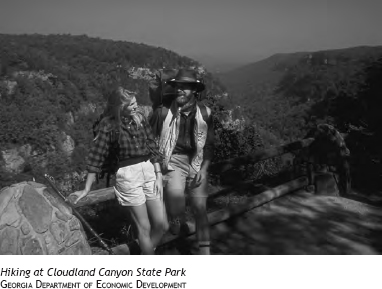
Hard Labor Creek State Park 2438 Knox Chapel Road, Rutledge, Ga. 30663 (800-864-7275 or 706-557-3001). Amenities here include a golf course, hiking and horse trails, cottages, and campsites. The park is open daily from 7 A.M. to 10 P.M. A parking fee is charged.
Hart State Park 330 Hart State Park Road, Hartwell, Ga. 30643 (800-864-7275 or 706-376-8756). Located on Hartwell Lake, Hart State Park offers fishing, swimming, camping, cottages, and canoe rentals. It is open daily from 7 A.M. to 10 P.M. A parking fee is charged; call for other fees.
James H. Floyd State Park U.S. 27 approximately three miles south of Summerville, Ga. (800-864-7275 or 706-857-0826). Fishermen (and fisherwomen) can try their luck in two stocked lakes in this quiet park. Hiking, camping, and cottages are also offered. The park is open daily from 7 A.M. to 10 P.M. A parking fee is charged; call for other fees.
John Tanner State Park 354 Tanners Beach Road, Carrollton, Ga. 30117 (800-864-7275 or 770-830-2222). This park offers boat rentals, motor lodge rooms, hiking, camping, and mini-golf. It is open daily from 7 A.M. to 10 P.M. A parking fee is charged; call for other fees.
Mistletoe State Park 3723 Mistletoe Road, Appling, Ga. 30802 (800-864-7275 or 706-541-0321). Located on Clarks Hill Lake, this park offers a beach, campsites, lodging, boat rentals, and biking and hiking trails. It is open daily from 7 A.M. to 10 P.M. A parking fee is charged.
Moccasin Creek State Park 3655 Ga. 197 North, Clarkesville, Ga. 30523 (800-864-7275 or 706-947-3194). Canoe rentals, a boat ramp, and a wheelchair-accessible fishing pier are some of the amenities at this park on Lake Burton. It is open daily from 7 A.M. to 10 P.M. A parking fee is charged; call for other fees.
Panola Mountain State Conservation Park Ga. 155, Stockbridge, Ga. 30281 (800-864-7275 or 770-389-7801). Located 18 miles southeast of Atlanta, this mountain park features exhibits, rare plants, trails, and guided hikes. It is open daily from 7 A.M. until dusk. A parking fee is charged.
Red Top Mountain State Park and Lodge Exit 285 off I-75 at Cartersville, Ga. 30121 (800-864-7275 or 770-975-4226). Located on Lake Allatoona, this park has a lodge, a restaurant, a beach, mini-golf, camping, and cottages. It is open daily from 7 A.M. to 10 P.M. A parking fee is charged; call for other fees.
Sweetwater Creek State Conservation Park Mount Vernon Road, Lithia Springs, Ga. 30057 (800-864-7275 or 770-732-5871). This park offers fishing and boat rentals on its 215-acre lake, picnic shelters, playgrounds, and hiking trails to the ruins of a Civil War textile mill. It is open daily from 7 A.M. to 10 P.M. A parking fee is charged.
Tallulah Gorge State Park 338 Jane Hurt Yarn Drive, Tallulah Falls, Ga. 30573 (706-754-7970 or 770-754-7979 for camping information). Hiking trails and a suspension bridge allow breathtaking views of the gorge. The park also offers fishing, camping, and a gift shop. It is open daily from 8 A.M. until dark. A parking fee is charged.
Unicoi State Park and Lodge 1788 Ga. 356, Helen, Ga. 30545 (800-864-7275 or 706-878-2201). This park offers rooms at the lodge, a restaurant, cottages, camping, hiking, and boat rentals. It is open daily from 7 A.M. to 10 P.M. A parking fee is charged; call for other fees.
Victoria Bryant State Park and Golf Course 1105 Bryant Park Road, Royston, Ga. 30662 (706-245-6270). In addition to a golf course and pro shop, the park has a campground, a swimming pool, a playground, and picnic areas along a stream. It is open daily from 7 A.M. until dark. A parking fee is charged.
Vogel State Park 7485 Vogel State Park Road, Blairsville, Ga. 30512 (800-864-7275 or 706-745-2628). This park offers a lake with a beach, cottages, camping, mini-golf, and a Civilian Conservation Corps museum. It is open daily from 7 A.M. to 10 P.M. A parking fee is charged.
Watson Mill Bridge State Park 650 Watson Mill Road, Comer, Ga. 30629 (800-864-7275 or 706-783-5349). The covered bridge in this park dates to 1885 and is the longest in Georgia. Camping, hiking, and fishing are available. The park is open daily from 7 A.M. to 10 P.M. A parking fee is charged; call for other fees.
Southwestern Georgia
F. D. Roosevelt State Park 2970 Ga. 190, Pine Mountain, Ga. 31822 (800-864-7275 or 706-663-4858). This was one of President Roosevelt’s favorite picnic sites. Amenities include camping, boat rentals, and horseback riding. The park is open daily from 7 A.M. to 10 P.M. A parking fee is charged.
Florence Marina State Park Ga. 39-C, Lumpkin, Ga. 31815 (800-864-7275 or 229-838-4244). Located 16 miles west of Lumpkin, this park offers a fishing pier, a marina, boat rentals, cottages, camping, and a swimming pool. It is open daily from 7 A.M. to 10 P.M. A parking fee is charged; call for other fees.
George T. Bagby State Park and Lodge Ga. 39, Fort Gaines, Ga. 39851 (800-864-7275 or 229-768-2571). This resort park four miles north of Fort Gaines offers a golf course, a marina, a lodge, boat rentals, cottages, and hiking. It is open daily from 7 A.M. to 10 P.M. A parking fee is charged; call for other fees.
Georgia Veterans Memorial State Park 2459-A U.S. 280 West, Cordele, Ga. 31015 (800-864-7275 or 229-276-2371). Situated on an 8,600-acre lake, this park offers a military museum, cottages, camping, boating, and fishing. It is open daily from 7 A.M. to 10 P.M. A parking fee is charged; call for other fees.
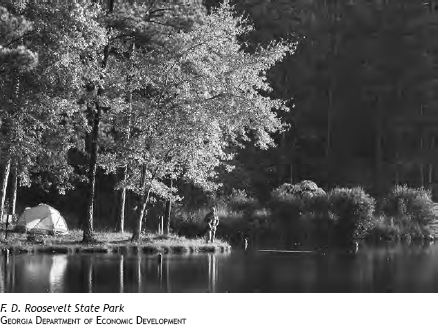
High Falls State Park 76 High Falls Park Drive, Jackson, Ga. 30233 (800-864-7275 or 478-993-3053). Visitors to this park on the Towaliga River can hike to the ruins of an 1880s gristmill, rent boats, camp, and swim in the pool. The park is open daily from 7 A.M. to 10 P.M. A parking fee is charged.
Indian Springs State Park 678 Lake Clark Road, Indian Springs, Ga. 30216 (800-864-7275 or 770-504-2277). Indians and travelers believed that the springs here had healing powers. The property was acquired by the state in 1825 and became a state forest park in 1927. Visitors can sample the spring water, tour the historic buildings, swim, boat, and hike. The park is open daily from 7 A.M. to 10 P.M. A parking fee is charged.
Kolomoki Mounds State Historic Park U.S. 27, Blakely, Ga. 39823 (800-864-7275 or 229-724-2150). Located six miles north of Blakely, these seven Native American mounds date to between 250 A.D. and 950 A.D. The park offers a museum and boat rentals. It is open daily from 8 A.M. to 5 P.M. A parking fee is charged; call for other fees.
Providence Canyon State Park Ga. 89-C, Lumpkin, Ga. 31815 (800-864-7275 or 229-838-6202). Located seven miles west of Lumpkin, Georgia’s “Little Grand Canyon” offers spectacular views and hiking trails. A parking fee is charged; call for hours and other fees. (See photograph on page 14).
Reed Bingham State Park Exit 39 off I-75 onto Ga. 37, Adel, Ga. 31620 (800-864-7275 or 229-896-3551). This park is six miles west of Adel. Located on a 375-acre lake, it offers fishing, watersports, boat tours, mini-golf, camping, and picnicking. The park is open daily from 7 A.M. to 10 P.M. A parking fee is charged.
Seminole State Park 7870 State Park Drive, Donaldsonville, Ga. 39845 (229-861-3137). Visitors can rent canoes and go bird watching, camping, swimming, and hiking.
Sprewell Bluff State Park 740 Sprewell Bluff Road, Thomaston, Ga. 30286 (800-864-7275 or 706-646-6026). Visitors can hike along the Flint River, go picnicking, and enjoy horseshoes and volleyball. The park is open daily from 7 A.M. until dark. A parking fee is charged.
Coastal Georgia
Crooked River State Park 6222 Charlie Smith Sr. Highway, St. Marys, Ga. 31558 (800-864-7275 or 912-882-5256). This park was the site of the McIntosh Sugar Works, built in 1825 and used as a starch factory during the Civil War. Today, it offers a boat ramp, mini-golf, cottages, campsites, and fishing. Visitors can rent kayaks from a nearby outfitter. Ferry trips to Cumberland Island are available.
General Coffee State Park Ga. 32, Nicholls, Ga. 31544 (800-864-7275 or 912-384-7082). Located six miles east of Douglas, this park has farm buildings, animals, cottages, a 19th-century house for rent, boat rentals, camping, fishing, and a swimming pool.
George L. Smith State Park 371 George L. Smith Park Road, Twin City, Ga. 30471 (800-864-7275 or 478-763-2759). Named for a former Georgia legislator, this park includes such attractions as a covered bridge, a gristmill, and a millpond that is a favorite spot for bird watchers. It offers camping, fishing, cottages, and boat rentals. The park is open daily from 7 A.M. to 10 P.M. A parking fee is charged.
Gordonia-Altamaha State Park U.S. 280, Reidsville, Ga. 30453 (800-864-7275 or 912-557-7744). Amenities at this park include a golf course, a pro shop, tennis courts, mini-golf, boat rentals, and camping and picnic areas. The park is open daily from 7 A.M. to 10 P.M. A parking fee is charged.
Hamburg State Park 6071 Hamburg State Park Road, Mitchell, Ga. 30802 (800-864-7275 or 478-552-2393). This park on a 225-acre lake offers a museum, a restored gristmill, a 1920s country store, boat rentals, fishing, and hiking. It is open daily from 7 A.M. to 10 P.M. A parking fee is charged.
Laura S. Walker State Park 5653 Laura Walker Road, Waycross, Ga. 31503 (800-864-7275 or 912-287-4900). Located near the Okefenokee Swamp, this park was named for a Georgia writer and naturalist. Its nature trails showcase a variety of wildlife, including alligators, owls, and blue herons. Other attractions include an 18-hole golf course, a pro shop, boat rentals, fishing, a swimming pool, and picnic areas. The park is open daily from 7 A.M. to 10 P.M. A parking fee is charged.
Little Ocmulgee State Park and Lodge U.S. 441, McRae, Ga. 31055 (877-591-5572 or 229-868-7474). Located two miles north of McRae on a 265-acre lake, this park has a golf course, a lodge, a restaurant, a nature trail, and a visitor center. It is open daily from 7 A.M. to 10 P.M.; the lodge is open 24 hours a day. A parking fee is charged.
Magnolia Springs State Park 1053 Magnolia Springs Drive, Millen, Ga. 30442 (800-864-7275 or 478-982-1660). Famous for its crystal-clear springs, the park site was a prison called Camp Lawton during the Civil War. Today, the park has a freshwater aquarium, a boardwalk, cottages, boat rentals, and hiking trails. It is open daily from 7 A.M. to 10 P.M. A parking fee is charged.
Stephen C. Foster State Park 17515 Ga. 177, Fargo, Ga. 31631 (800-864-7275 or 912-637-5274). Located on the banks of the Suwannee River, this park is aptly named for the famous songwriter. It also is the gateway to the Okefenokee National Wildlife Refuge. A parking fee is charged; call for hours and other fees.
Anyone 16 or older is required to have a current Georgia fishing license in his or her possession while fishing in fresh water or salt water in Georgia. Identification may be required by Georgia conservation rangers. Exceptions are made for fishing in privately owned ponds and for landowners and their immediate families fishing on their own land.
Proof of residence (a Georgia driver’s license or other ID) is required to purchase a fishing license. Resident anglers from 16 to 64 are required to have a current Georgia fishing license in their possession while fishing. Residents 65 or older may fish with a Senior Lifetime License. Residents who are permanently and totally disabled may obtain a Disability Honorary Combination Hunting and Fishing License by providing proof of their disability. Blind residents must provide a physician’s certification of blindness with the application.
Nonresidents under 16 do not need a fishing or trout license. Those 16 or older must have a current nonresident Georgia fishing license to fish in Georgia, except in private ponds. College students enrolled full time in Georgia may purchase a resident fishing license if they have a current student ID. Military personnel on active status at a Georgia base and their immediate family members may buy a resident fishing license.
All residents between the ages of 16 and 64 must have a trout license as well as a current fishing license to fish in designated trout waters. Residents with a Senior Lifetime License and honorary license holders are not required to have a trout license. Nonresident anglers must have a nonresident fishing license and a trout license to fish in designated trout waters.
All recreational hunting and fishing licenses are good for one year from the date of purchase.
A regular fishing license for residents is $9. A nonresident license is $24 for a season, $7 for seven days, or $3.50 for one day. A trout license is $5 for a resident and $13 for a nonresident. A combination fishing and hunting license is $17 for a resident; it is not available for nonresidents. A license for wildlife management areas is $19 for residents and $73 for nonresidents.
A sportsman’s license includes fishing, trout fishing, wildlife management area, hunting, big-game hunting, primitive weapons hunting, and waterfowl conservation licenses. It can be purchased for $60. It does not include the federal duck stamp. Sportsman’s licenses are not available for nonresidents.
Lifetime hunting and fishing licenses are available for the following fees: $200 for infants under age two; $350 for children between two and 15; and $500 for adults 16 and older. A Senior Discount Lifetime License costs $95; seniors 65 and older can obtain a free Honorary Lifetime License. You must be a Georgia resident for at least 12 months immediately prior to applying for a lifetime license. The license is valid even if you move out of state. Lifetime licenses for nonresident grandchildren ages 15 and younger are available for $1,000.
Georgia fishing licenses are available at more than 1,100 discount stores, marinas, and stores that sell sporting goods, bait and tackle, and hardware. Licenses can also be purchased in person at the Department of Natural Resources, License Unit, 2065 U.S. 178, Social Circle, Ga. 30025 (800-366-2661). Your Social Security number is required at the time of purchase.
Owners must obtain a certificate and a decal before operating their boats in Georgia. Boat registration applications are available from any Wildlife Resources Division office and from boat dealers, hardware and sporting goods stores, and marinas. The temporary certificate on the registration form allows owners to operate their boats until they receive a permanent certificate and decal by mail.

Fees for a three-year boat registration are as follows: $15 for boats less than 16 feet (class A); $36 for boats 16 to 26 feet (class 1); $90 for boats 26 to 40 feet (class 2); and $150 for boats 40 feet or longer (class 3). Additional fees include $3 for transfer, $1 for duplicates, and $5 for marine toilets.
Boats must have a life jacket for each person aboard, as well as a throwable floatation device. Boats may be operated only by persons 16 or older. They may not be operated faster than idling speed within 100 feet of other boats, people, or the shoreline near beaches, residences, and public-use areas. A five-miles-per-hour speed limit is in force for Jet Skis in those same areas.
Food festivals are listed at the end of the “Food and Drink” chapter. Here is a list of other festivals:
Crape Myrtle Festival, Marshallville (July)
Redneck Games, East Dublin (July)
Georgia Mountain Fair, Hiawassee (July)
Annual Butternut Creek Festival, Blairsville (July)
Winged Wonders Butterfly Festival, Thomasville (July)
Commerce Crossing Art & Antique Fest, Commerce (August)
Pigs and Peaches BBQ Cookoff, Kennesaw (August)
Angel City Bluegrass Festival, Unadilla (August)
Grant Park Summer Shade Festival, Atlanta (August)
Decatur Book Festival, Decatur (Labor Day weekend)
Mountain Marketplace Heritage Festival, Blairsville (Labor Day weekend)
Farm Day Festival, Lumber City (September)
Lovejoy Autumn Festival, Lovejoy (September)
North Georgia State Fair, Marietta (September)
Annual Fall Bluegrass Festival, Cochran (September)
Westobou Festival, Augusta (September)
Sandy Springs Festival, Sandy Springs (September)
Family Fun Day, Bogart (September)
Union Junction Jamboree, Union Point (September)
La Fiesta del Pueblo, Tifton (September)
Shady Days in Gay, Gay (October)
Friendship Festival, Social Circle (October)
Cotton Pickin’ Fair, Gay (October)
Sherman’s Last Burning Fall Festival, Covington (October)
Sorghum Festival, Blairsville (October)
Cochran-Bleckley Country Fest, Cochran (October)
Hummingbird Festival, Hogansville (October)
Atlanta Travel Guide. www.atlanta.net.
Explore Georgia. www.explorega.org.
Georgia Travel Guide. www.georgia.org.
Homan, Tim. Hiking Trails of North Georgia. Atlanta, Ga.: Peachtree Publishers, 1997.
Lenz, Richard J. Highroad Guide to the Georgia Coast and Okefenokee. Winston-Salem, N.C.: John F. Blair, Publisher, 2003.
Northeast Georgia Travel Association. www.georgiamountains.org.
Porter, Darwin, and Danford Prince. Frommer’s Portable Savannah. Frommer’s, 2005.